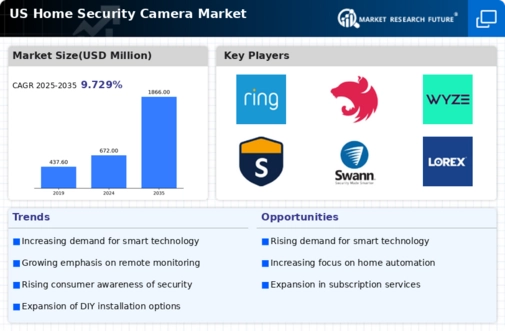Rising Crime Rates
The increasing incidence of crime in various urban and suburban areas appears to be a significant driver for the home security-camera market. As residents seek to protect their properties and loved ones, the demand for security cameras has surged. According to recent data, property crime rates in the US have shown a troubling upward trend, prompting homeowners to invest in surveillance solutions. This heightened concern for safety is likely to propel the market forward, as individuals prioritize security measures. The home security-camera market is thus experiencing a robust growth trajectory, with projections indicating a potential increase in market size by over 10% annually in response to these rising crime statistics.
Technological Advancements
The rapid evolution of technology is transforming the home security-camera market. Innovations such as artificial intelligence, cloud storage, and mobile connectivity are enhancing the functionality and appeal of security cameras. For instance, features like motion detection, facial recognition, and real-time alerts are becoming standard, making these devices more attractive to consumers. The integration of smart home systems further amplifies this trend, as homeowners seek seamless connectivity between devices. As a result, the home security-camera market is likely to witness a significant uptick in adoption rates, with estimates suggesting that smart security solutions could account for over 60% of total sales by 2026.
Affordability of Security Solutions
The decreasing costs of security cameras and related technologies are making home security more accessible to a broader audience. With prices for high-quality cameras dropping significantly, even budget-conscious consumers can now invest in home surveillance systems. This trend is particularly evident in the home security-camera market, where a variety of options are available at different price points. The introduction of competitively priced models has expanded the consumer base, allowing more households to consider security cameras as a viable option. Consequently, the home security-camera market is likely to see a substantial increase in market penetration, with projections indicating a potential growth rate of 12% annually as affordability continues to improve.
Increased Awareness of Home Security
There is a growing awareness among consumers regarding the importance of home security, which is driving the home security-camera market. Educational campaigns and media coverage about burglary and theft incidents have heightened public consciousness about the need for surveillance. This awareness is particularly pronounced among millennials and Gen Z, who are more inclined to invest in technology-driven solutions. As a result, the home security-camera market is experiencing a shift in consumer behavior, with more individuals prioritizing security investments. Market analysis indicates that this trend could lead to a 15% increase in sales over the next few years as more households adopt security cameras as a standard precaution.
Regulatory Support for Security Measures
Government initiatives aimed at enhancing public safety are contributing to the growth of the home security-camera market. Various local and state programs encourage homeowners to adopt security measures, including financial incentives for installing surveillance systems. This regulatory support not only promotes the use of security cameras but also fosters a culture of safety within communities. As municipalities recognize the benefits of surveillance in crime prevention, the home security-camera market is poised for growth. Current estimates suggest that such initiatives could lead to a 20% increase in market demand over the next five years, as more homeowners take advantage of available programs to enhance their security.

















Leave a Comment